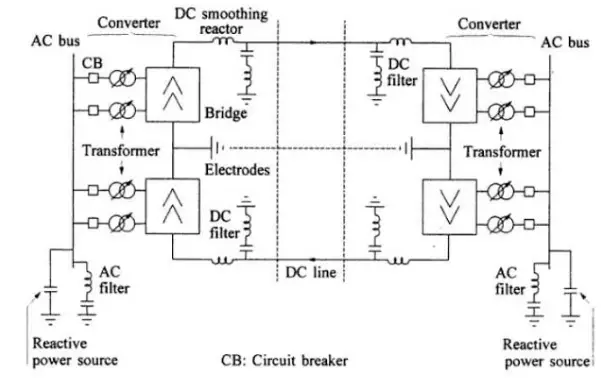In the previous article, we learnt about HVDC Transmission System, its advantages and disadvantages. In this article, we will discuss the main components of HVDC Transmission System.

The main components associated with HVDC system are as follows
- Converter
- Smoothing reactor
- Harmonic filters
- Reactive Power Supplies
- Electrodes
- DC lines
- AC Circuit Breaker
1. Converters
They perform AC to DC and DC to AC conversion and consists of valve bridges and transformers with tap changers. The valve bridges consist of high voltage valves connected in a six-pulse or 12 pulse arrangement.
2. Smoothing Reactors
These are large reactors having inductance as high as 1 Henry connected in series with each pole of each converter stations. They serve the following purpose:
- Decrease harmonic voltages and currents in DC line.
- Prevent commutation failure in inverters.
- Prevent current from being discontinuous at light load.
- Limit the crest current in the rectifier during the short circuit in DC line.
3. Harmonic Filters
Converters generate harmonic voltages and currents on both AC and DC sides. These harmonics may cause overheating of capacitors nearby generators and interference with telecommunication systems. Filters are therefore used on both AC and DC sides.
4. Reactive Power Supplies
DC converters inherently absorb reactive power under steady state conditions. The reactive power consumed is about 50% of the active power transferred.
Under transient conditions, the consumption of reactive power may be much higher. Reactive power sources are therefore provided near the converters. For strong AC systems, these are usually in the form of shunt capacitance/capacitor.
Depending upon the demands placed on DC link and on the AC system, part of the reactive power source may be in the form of a synchronous condenser or static VAR compensator (SVC).
Capacitors associated with AC filters also provide part of the reactive power required.
5. Electrodes
Most DC links are designed to use earth as mutual conductor for atleast brief periods of time. Connection to the earth requires a large surface area conductor to minimise current densities and surface voltage gradients. This conductor is referred to as electrodes.
If it is necessary to restrict the current flow through the earth, a metallic return conductor may be provided as part of DC line.
6. DC Lines
They may be overhead lines or cables except for the number of conductor and spacing required, the DC lines are very similar to AC lines.
7. AC Circuit Breaker
For clearing faults in the transformer and taking DC links out of service, Circuit breakers are used on the AC side. They are not used for clearing DC faults twice. These faults may be cleared more rapidly by converter control.
